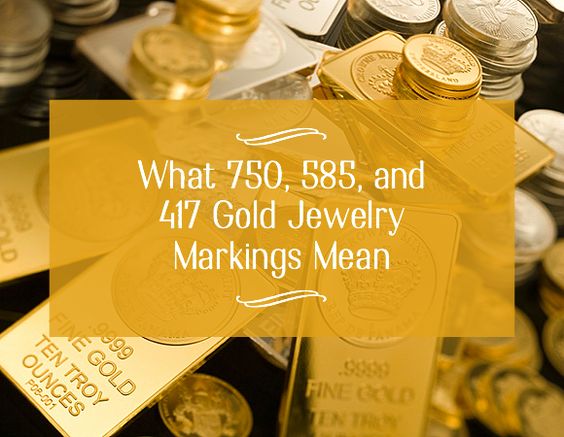How to Check 750, 585, 417 Jewelry Markings: What Does Really Mean?
- Posted on 17th March 2023
- in Antique Gold and Jewelry, Antique Jewelry, Antique Jewelry value
- by Alan
Silver markings and gold markings symbols are often the simplest way to learn essential information about your gold jewelry. These markings, which are part of a broad range of jewelry, stamps, are designed to impart specific information about the gold or silver used in jewelry to the buyer or wearer. Let’s take a closer look at how you can learn to identify 750 gold, 585 gold and other similar markings and uncover what they really mean.

Gold Markings Symbols: 750 gold, 585 gold and more
750 gold is also known as 18 karat (18K) gold, and it means that the gold is 75% pure gold, with the remaining 25% being made up of other metals such as silver, copper, or zinc. The 750 marking is commonly found on high-end jewelry pieces.
585 gold is also known as 14 karat (14K) gold, and it means that the gold is 58.5% pure gold, with the remaining 41.5% made up of other metals. The 585 marking is commonly found on mid-range jewelry pieces.
417 gold is also known as 10 karat (10K) gold, and it means that the gold is 41.7% pure gold, with the remaining 58.3% made up of other metals. The 417 marking is commonly found on lower-end jewelry pieces.
999 or 9999 – This indicates that the gold is 99.9% or 99.99% pure, respectively. These markings are often found on bullion bars or coins.
GF or GP – These markings indicate that the piece is gold-filled or gold-plated, respectively. Gold-filled jewelry has a layer of gold bonded to a base metal, while gold-plated jewelry has a thin layer of gold applied to a base metal.
HGE or HGP – These markings indicate that the piece is “heavy gold electroplate” or “heavy gold plate.” This means that the piece has a thicker layer of gold than regular gold-plated jewelry.
To check for these markings, look for a stamp or engraving on the inside of the jewelry piece. The markings may also be accompanied by other symbols or letters that indicate the manufacturer, the country of origin, or the year the piece was made.
It’s important to note that the higher the purity of the gold, the more valuable it is. However, the purity of the gold does not necessarily indicate the quality or beauty of the piece itself. Other factors such as the design, craftsmanship, and condition of the jewelry also play a role in determining its value.
How to Check For Gold Markings
Whether you’re checking for silver markings or gold markings, there is one essential rule to keep in mind: check, check, and double check. It’s not always easy to find the jewelry, stamps on a piece of jewelry, especially if it is an older piece or has come from a foreign market. Once you have practice inspecting your pieces for markings, however, you will find it becomes easier over time to spot them. A good rule of thumb is to look at the underside of the jewelry–such as inside a ring or on the back of an earring post–which is not normally exposed to the area.
Depending on when and where the jewelry was made, you may notice some makers preferred to mark their jewelry with the karat level rather than the purity level (750 gold, 585 gold, and so on); this is not uncommon nor does it necessarily mean your gold is fake. If you suspect the imprint may be fake, it’s time to break out your high quality magnifying glass for a closer look; fake jewelry, stamps to look more undefined and are applied in a slapdash fashion when compared to the genuine deal.
Final Thoughts
Whether you’re interested in antique gold jewelry, antique silver jewelry or you prefer modern pieces, it’s important to know what the markings on your jewelry mean and how you can use those markings to further identify the pieces in your possession. Keep the above guide in mind when inspecting your jewelry.
